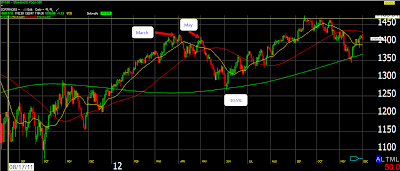There’s very old saying on Wall Street; “Sell In May and Go Away,” like everything else, sometimes it works sometimes it doesn’t. The market has hit a short-term peak in the month of May enough times to respect the saying.
Here’s the SP500 average return in the past 10-years and during post-election year; peak in May, low in June, retest in the fall. This could be used as a guideline.
The great Urban Carmel from Fat-Pitch.blogspot.com pointed out that the average intra-year decline when the SP500 has been positive January and February is roughly -7 to -9%.
The reason why Urban is highlighting only the years in which the market was up January and February is that historically when January and February are up months, the market does very well for the entire year. Since 1950 when the SP500 was higher the first two months 26 times, 24 of those times it was higher by year end. Here’s the research by Ryan Detrick.
What I found interesting was that the most recent pullbacks under this January-February criteria have commenced in the month of May.
- 2013 it was a 1-month shake out that started in May -7.5%.
- 2012 a 1-month shake out that also happened in May -11%.
- 2011 a 19% pullback that commenced in May.
- 2006 an 8% pullback that began in May.
Right now price action is not giving us any clues that we are going to roll over and follow the previous script, but if you look at the charts above we did not get any clues back then either. The SP500 just peaked at highs and rolled over.
Bottom line; as you can see on the charts above every pullback ended up being a buying opportunity, the short term pain became a long term gain.
Bottom line; as you can see on the charts above every pullback ended up being a buying opportunity, the short term pain became a long term gain.
SIGN UP HERE FOR OUR STOCK PICK OF THE WEEK.
Frank Zorrilla, Registered Advisor In New York. If you need a second opinion, suggestions, and or feedback in regards to the market feel free to reach me at fzorrilla@zorcapital.com or 646-480-7463.
We live in a world in which we are bombarded with information, tweets, blogs, etc., content is the new salesman, content is the new marketing, content is the new networking. With information being so readily available, bloggers try to differentiate themselves with their writing skills, volume, and consistency, putting out blog posts to meet quotas. We are seeking to stand out from the crowd by showing performance, by taking all the information and seeking alpha, that’s the sole purpose of the blog. It won’t always be pretty; it’s never easy, and performance is spotty, but we seek superior risk-adjusted returns, not notoriety for our writing skills. If this is something you can relate to, then this blog is for you.









Leave A Comment